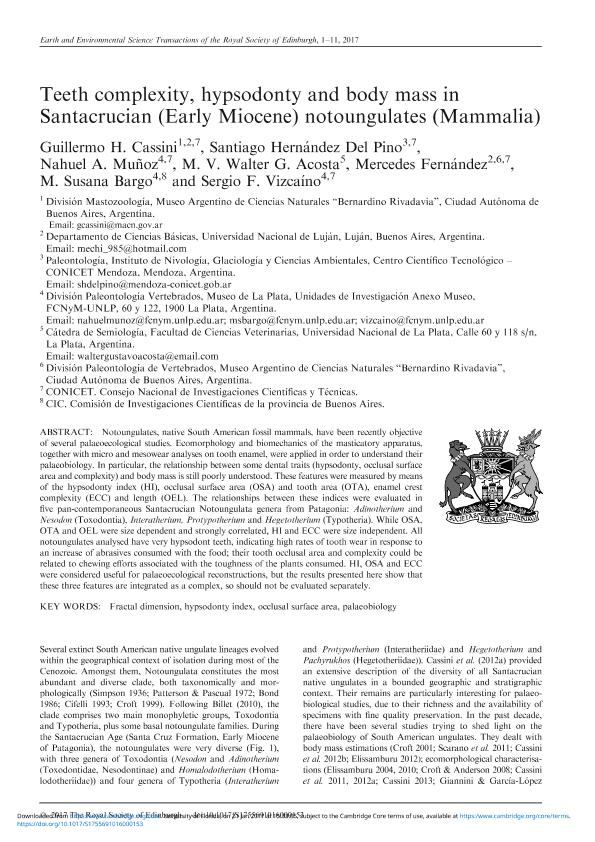Mostrar el registro sencillo del ítem
dc.contributor.author
Cassini, Guillermo Hernán

dc.contributor.author
Hernández del Pino, Santiago Ezequiel

dc.contributor.author
Muñoz, Nahuel Antu

dc.contributor.author
Acosta, Walter Gustavo

dc.contributor.author
Fernández, Mercedes

dc.contributor.author
Bargo, María Susana

dc.contributor.author
Vizcaíno, Sergio Fabián

dc.date.available
2018-06-15T21:59:45Z
dc.date.issued
2017-02
dc.identifier.citation
Cassini, Guillermo Hernán; Hernández del Pino, Santiago Ezequiel; Muñoz, Nahuel Antu; Acosta, Walter Gustavo; Fernández, Mercedes; et al.; Teeth complexity, hypsodonty and body mass in Santacrucian (Early Miocene) notoungulates (Mammalia); Royal Society of Edinburgh; Earth and Environmental Science Transactions of the Royal Society of Edinburgh; 106; 4; 2-2017; 303-313
dc.identifier.issn
1755-6910
dc.identifier.uri
http://hdl.handle.net/11336/48917
dc.description.abstract
Notoungulates, native South American fossil mammals, have been recently objective of several palaeoecological studies. Ecomorphology and biomechanics of the masticatory apparatus, together with micro and mesowear analyses on tooth enamel, were applied in order to understand their palaeobiology. In particular, the relationship between some dental traits (hypsodonty, occlusal surface area and complexity) and body mass is still poorly understood. These features were measured by means of the hypsodonty index (HI), occlusal surface area (OSA) and tooth area (OTA), enamel crest complexity (ECC) and length (OEL). The relationships between these indices were evaluated in five pan-contemporaneous Santacrucian Notoungulata genera from Patagonia: Adinotherium and Nesodon (Toxodontia), Interatherium, Protypotherium and Hegetotherium (Typotheria). While OSA, OTA and OEL were size dependent and strongly correlated, HI and ECC were size independent. All notoungulates analysed have very hypsodont teeth, indicating high rates of tooth wear in response to an increase of abrasives consumed with the food; their tooth occlusal area and complexity could be related to chewing efforts associated with the toughness of the plants consumed. HI, OSA and ECC were considered useful for palaeoecological reconstructions, but the results presented here show that these three features are integrated as a complex, so should not be evaluated separately.
dc.format
application/pdf
dc.language.iso
eng
dc.publisher
Royal Society of Edinburgh

dc.rights
info:eu-repo/semantics/openAccess
dc.rights.uri
https://creativecommons.org/licenses/by-nc-sa/2.5/ar/
dc.subject
Fractal Dimension
dc.subject
Hypsodonty Index
dc.subject
Occlusal Surface Area
dc.subject
Palaeobiology
dc.subject.classification
Meteorología y Ciencias Atmosféricas

dc.subject.classification
Ciencias de la Tierra y relacionadas con el Medio Ambiente

dc.subject.classification
CIENCIAS NATURALES Y EXACTAS

dc.title
Teeth complexity, hypsodonty and body mass in Santacrucian (Early Miocene) notoungulates (Mammalia)
dc.type
info:eu-repo/semantics/article
dc.type
info:ar-repo/semantics/artículo
dc.type
info:eu-repo/semantics/publishedVersion
dc.date.updated
2018-06-04T17:09:52Z
dc.journal.volume
106
dc.journal.number
4
dc.journal.pagination
303-313
dc.journal.pais
Reino Unido

dc.journal.ciudad
Edimburgo
dc.description.fil
Fil: Cassini, Guillermo Hernán. Consejo Nacional de Investigaciones Científicas y Técnicas. Oficina de Coordinación Administrativa Parque Centenario. Museo Argentino de Ciencias Naturales “Bernardino Rivadavia”; Argentina. Universidad Nacional de Luján. Departamento de Ciencias Básicas; Argentina
dc.description.fil
Fil: Hernández del Pino, Santiago Ezequiel. Consejo Nacional de Investigaciones Científicas y Técnicas. Centro Científico Tecnológico Conicet - Mendoza. Instituto Argentino de Nivología, Glaciología y Ciencias Ambientales. Provincia de Mendoza. Instituto Argentino de Nivología, Glaciología y Ciencias Ambientales. Universidad Nacional de Cuyo. Instituto Argentino de Nivología, Glaciología y Ciencias Ambientales; Argentina
dc.description.fil
Fil: Muñoz, Nahuel Antu. Consejo Nacional de Investigaciones Científicas y Técnicas. Centro Científico Tecnológico Conicet - La Plata; Argentina. Universidad Nacional de La Plata. Facultad de Ciencias Naturales y Museo. División Paleontología Vertebrados; Argentina
dc.description.fil
Fil: Acosta, Walter Gustavo. Universidad Nacional de La Plata. Facultad de Ciencias Veterinarias; Argentina
dc.description.fil
Fil: Fernández, Mercedes. Consejo Nacional de Investigaciones Científicas y Técnicas. Oficina de Coordinación Administrativa Parque Centenario. Museo Argentino de Ciencias Naturales “Bernardino Rivadavia”; Argentina. Universidad Nacional de Luján. Departamento de Ciencias Básicas; Argentina
dc.description.fil
Fil: Bargo, María Susana. Provincia de Buenos Aires. Gobernación. Comisión de Investigaciones Científicas; Argentina. Universidad Nacional de La Plata. Facultad de Ciencias Naturales y Museo. División Paleontología Vertebrados; Argentina
dc.description.fil
Fil: Vizcaíno, Sergio Fabián. Consejo Nacional de Investigaciones Científicas y Técnicas. Centro Científico Tecnológico Conicet - La Plata; Argentina. Universidad Nacional de La Plata. Facultad de Ciencias Naturales y Museo. División Paleontología Vertebrados; Argentina
dc.journal.title
Earth and Environmental Science Transactions of the Royal Society of Edinburgh

dc.relation.alternativeid
info:eu-repo/semantics/altIdentifier/doi/http://dx.doi.org/10.1017/S1755691016000153
dc.relation.alternativeid
info:eu-repo/semantics/altIdentifier/url/https://www.cambridge.org/core/journals/earth-and-environmental-science-transactions-of-royal-society-of-edinburgh/article/teeth-complexity-hypsodonty-and-body-mass-in-santacrucian-early-miocene-notoungulates-mammalia/B3DC03EF53287097964D921D90571760
Archivos asociados
